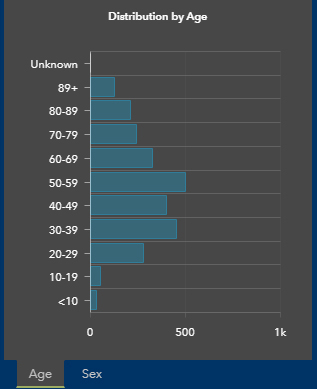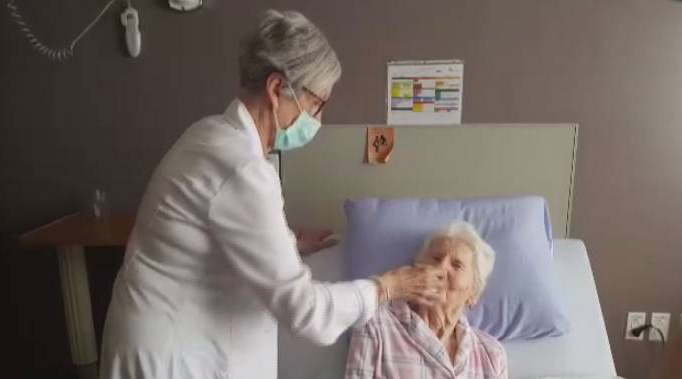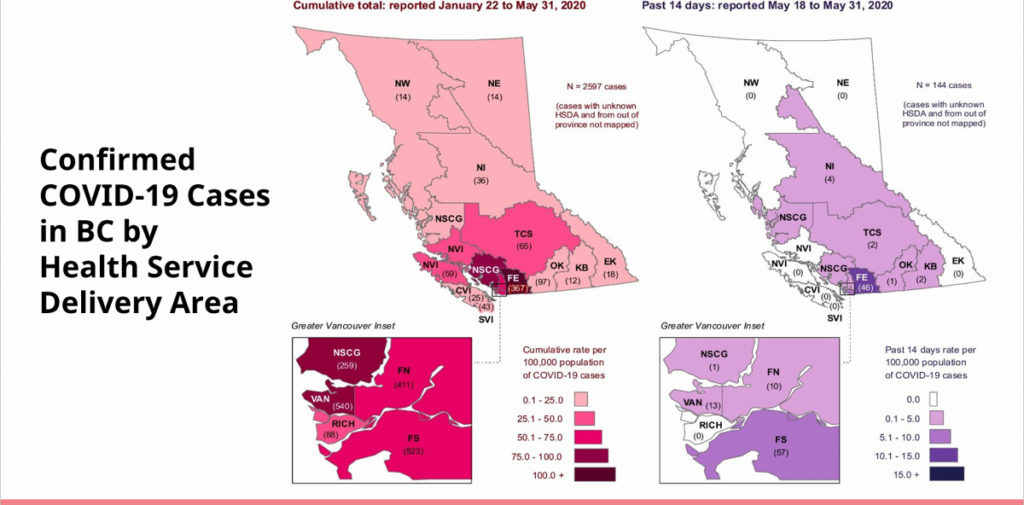Thursday June 4, 2020 ~ VICTORIA, BC
by Mary Brooke, B.Sc. ~ West Shore Voice News
The ‘COVID-19: Going Forward data modelling for the course of illness and pandemic in BC’ was presented today by Provincial Health Officer Dr Bonnie Henry, along with Health Minister Adrian Dix.
The epidemiological theme was to explore and propose “how and where the virus has affected people in BC”.
Based on 2,553 cases between January 1 and May 27, 2020 (and testing only on seen or suspected cases) the peak case count was seen on March 25, with three other (but slightly lower) peaks on April 21, 25 and 27.
Age-related data in BC:

Numerically in BC, the highest number of COVID-19 test-positive cases (488) appears in the 50 to 59 year age group, followed by the 30 to 39 year old age group (442 cases). This reflects the age of workers on the front lines of health care.
In the age groupings over age 60, the case count goes down by age: 324 for age 60 to 60; 239 for age 70 to 79; 212 for age 80 to 89; and 128 for age 90+.
Almost all of the deaths from COVID-19 in BC have occurred in people older than age 60, with the highest counts in the 80 to 89 age group (70 deaths) and the 90+ age group (43 deaths).
There is still risk:

“The risk is still out there,” says Dr Henry. She says it’s “a challenge to present the data, to present it consistently, to help people understand”… “that once exposed there is no way of preventing you from getting sick”.
Thousands of people that they are watching closely (close contacts of known cases) “will develop the illness”. Dr Henry says the impact is “much broader” if the known case has tested positive for COVID-19.
“We know people move. The virus is transmitted from people to people,” said Dr Henry in a media briefing today. “We can’t say there is no risk when the virus is all around us,” she affirmed.

People of any age can acquire the COVID-19 viral infection.
The action of the illness tends to be less severe in children (though there can be post-infection cardiovascular reactions). No children in BC have died from COVID-19, which is of course a relief to all. But the number of cases has been rising this week: up from 80 last week, to 84 yesterday, and 86 today (54 in the 10 to 19 age group, and 32 under age 10) which is 3.3% of cases.
Most of the 2,632 COVID-19 cases in BC have been among working-age adults between the ages of 20 to 59 (1,634 cases or 62%), but few deaths. Most of those adult cases would be by community transmission (in many cases by way of the work places and/or a home environment with spread between in-home family members). It is from workers in care homes that the virus has reached seniors in the compact living conditions that exist in long-term care homes.
Most of the deaths from COVID-19 have been in people over age 60, which speaks mostly to the action of the virus on the oxygenation capability of cells (leading to micro-vascular malfunction, and subsequently in serious caes to impaired lung function) and the presumably lower robustness of immune systems in older people. As well, it is known that more compact living conditions (such as in long term care homes and lower-income households) leads to greater spread.
Long term care homes have seen most of the COVID-19 deaths:

Dr Henry says the most potent area of spread is between people in close contact living scenarios. More space is better, as in ‘fewer spaces, bigger spaces’.
Most of the deaths among seniors (96 of them to date) have occurred in long term care homes, where outbreaks have presented challenges.
Dr Henry has explained before and reiterated today that once seniors have contracted the illness they oftentimes decline relocation to hospital (where they would possibly end up on mechanical support with a ventilator, which usually requires consistent sedation), preferring to take their chances with a natural progression of the disease in a familiar environment.
Dr Henry said today that families may take their elderly family members out of long term care at any time, if they wish to care for those loved ones at home. But today she firmly stated that she sees improvements to the long term care health provisions as the preferred longer term option.

Meanwhile, for families prevented from seeing their loved ones in care homes (due to COVID-19 transmission prevention protocols) and the expected ongoing long duration of COVID-19 in the province until there is a vaccine, caring for a senior family member at home may become a choice for some families who will be weighing the emotional benefits vs the (previous) convenience or suitability of institutional long-term care.
Where the virus arrived from:
By determining changes in the RNA (genetic material) of the virus from test-positive samples in BC, the general geographic source of the incoming COVID-19 infections can be determined. This of course is reflective of people’s travel patterns.

Early cases of COVID-19 came into BC via people who had travelled back to BC from China (mostly Wuhan) and Iran, then from Italy, Germany and France, as well as Washington State.
The earliest cases in January and February were from China, mostly the Wuhan area. In February, incoming cases carried a strain by people returning from travel in Iran, before that was noted by the World Health Organization as a source of outbreak. In March was the onset of infection by way of travellers returning from Washington State, China and Europe as well as Eastern Canada.

Dr Henry outlined that COVID-19 is still active in Washington State just south of BC, but that “we are blocking that because fewer people coming across the border”.
She says there are active cases in Alberta and Alaska, for which there is some risk of transmission due to mobility of people for work or travel.
“We can’t always tell when someone’s coming in” as to whether they will have an active case of the virus, she stated as one of the uncontrollable unknowns.
Yesterday Premier John Horgan further encouraged British Columbians to be tourists in their own province this summer, as part of helping to reduce the spread of COVID-19 but also to help keep the BC tourism sector afloat. More to come on that in the days and weeks ahead, he said.
Sticking to the program:

“We need to continue to do the things we are doing,” said Dr Henry, referring of course to the entire spectrum of successful techniques that she and her public health team have taught people to do (e.g. physical distancing, hand hygiene, staying home if ill, etc.).
We have followed an evidence-based approach to management of the pandemic in BC, said Minster Dix, as what he feels is the main reason for success of flattening the curve in this province, compared to what has been seen in other jurisdictions. He continues to urge all British Columbians to be “100 percent all in” with adhering to measures like physical distancing, frequent hand washing, and staying home if feeling even the least bit unwell.
Dr Henry also commended all British Columbians for the success of BC’s relatively low number of cases and controlled degree of spread of COVID-19. She is in large part the star of the COVID-19 show in BC — the architect of BC’s flattened epidemiological curve –, with her ability to deliver public health education, step by step, and thereby guiding an entire population in the right direction for health and a reasonably good economic recovery.
Micro focus on Vancouver Island:
Most people who have been following the impact of COVID-19 on south Vancouver Island have noticed the relatively few cases here, and a relatively low number of hospitalizations.
Presently there have been 130 test-positive cases of COVID-19 in the Island Health region.

Today Dr Henry suggested that part of the source of Vancouver Island cases being mostly the European-based strain of COVID-19 is a reflection of where people (who live on Vancouver Island) travel to.
Otherwise, a lot of it is “luck and timing”, according to the Provincial Health Officer.
Epi-Links now in the statistics:
Today Dr Henry introduced another way of reporting cases into the COVID-19 database, called ‘Epi-linked’.
An epi-linked case of COVID-19 means that public health investigations have shown that cases meet the case definition for COVID-19 but may not have been tested for a number of reasons, are either related to each other, or that a common source of infection has been identified. In future reports, new tested and epi-linked cases will be included as one number.
Today new epi-linked cases were added to the tallies for Vancouver Island and Vancouver Coastal health regions.
===== LINKS:
The full June 4, 2020 “Going Forward” data modelling document is on the BC CDC website.
![Hon John Horgan, MLA [Langford-Juan de Fuca]](https://islandsocialtrends.ca/wp-content/uploads/2020/04/LFDJdFConstituency-WSVN-covid-banner-728x90-web.jpg)




